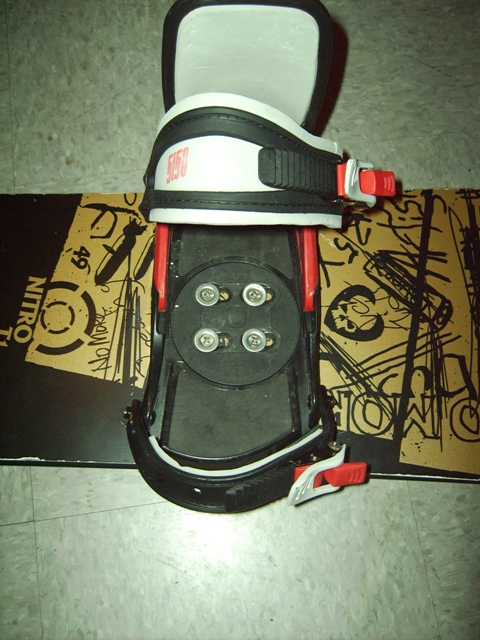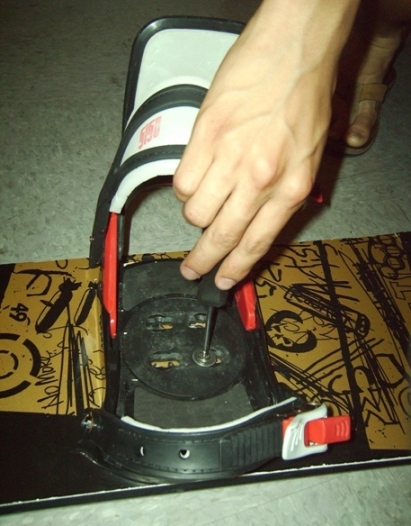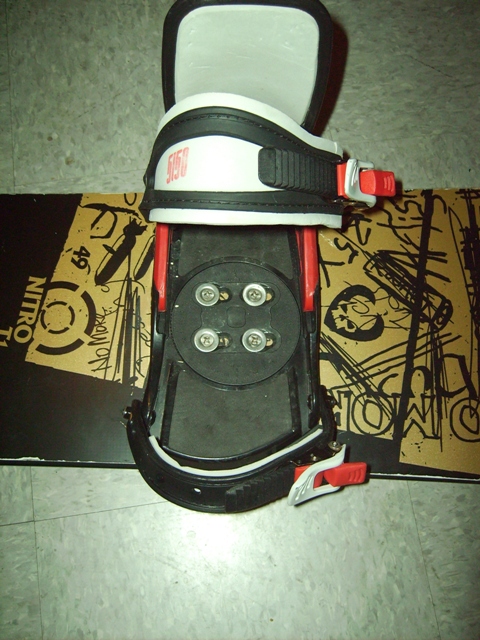Snowboard binding
From DDL Wiki
Team 7:
Hamilton, Sean
Karoubalis, Spiro
Li, Michael
Santiago, Kaila
Stakeholders
We have identified three major stakeholders in snowboard bindings: the Customer, the Manufacturer, and the Retailer. All have something to be gained from decisions about the product which is identified in detail below.
Customers: Customers are the primary users of the snowboard bindings. They benefit from a low cost product with high quality and durability. In addition, customers value convenience, comfort, and ease of use.
- The product must be of high quality materials and durable enough for use in extreme conditions. Customers would not purchase a product that does not enable them to remain attached to the board while in use.
- The product must be relatively light weight for ease of transportation. Snowboarders will be carrying the board and attached bindings to and from the mountain, sometimes over long distances. We would like to limit the weight in the bindings to increase comfort of cross ground carrying.
- The product needs to be able to be used by all types of users of all ages and skill levels.
- Needs to be easy to operate with gloves on.
- Needs to operate in cold weather (durable).
- Customers are also concerned about the following factors:
- Cost
- Aesthetics
- Storability
- Customizability
- Safety
- Reliability
Manufacturers are impacted by the manufacturability and the easy of assembly of the product.
- Materials, manufacturing, and assembly costs
- Part Count (ideally low)
- Transportation costs (from moving raw materials to manufacturing location)
- Production time: Manufacturers are impacted by how long it takes to produce the product
Retailers are impacted by packaging, price and other factors.
- Ease of storage: for transportation, warehousing, and displaying
- Size of package: to maximize use of store floor space
- Needs to be lightweight to lower transportation costs
User Study
Snowboard bindings are essential to the functionality of the sport. The bindings enable the rider to use his/her body weight to control the snowboard. The mounting disc of the bindings functions as the sole attachment that keeps the bindings from disconnecting from the board. Strap-in bindings are most commonly used on the mountain. The binding examined was a 5150 binding.
Initial Assembly:
The use of the bindings is relatively simple. The rider first begins by attaching the bindings to the board. To do this, the rider must first decide what angle he wishes the mounting disc to be set. The rider then aligns the mounting disc slots and screws in the mounting disc (four screw locations, using a philips head screwdriver). Based on the style of riding preferred, the rider may also adjust the hi back support using the forward lean adjustment tab.
With the mounting disc in place, the rider can then insert his snowboarding boot into the binding.
Ideally, the rider straps in first using the upper strap, followed by the toe strap, and then adjusts the ratchets to the desired support.
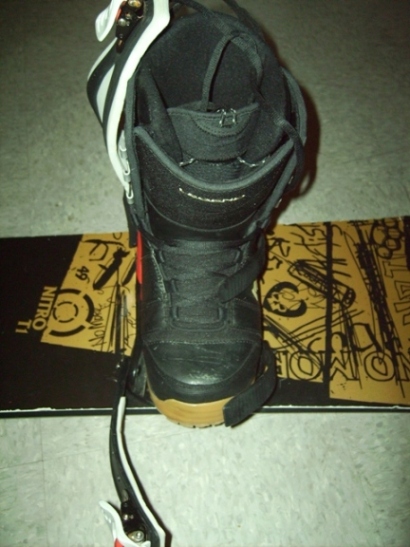
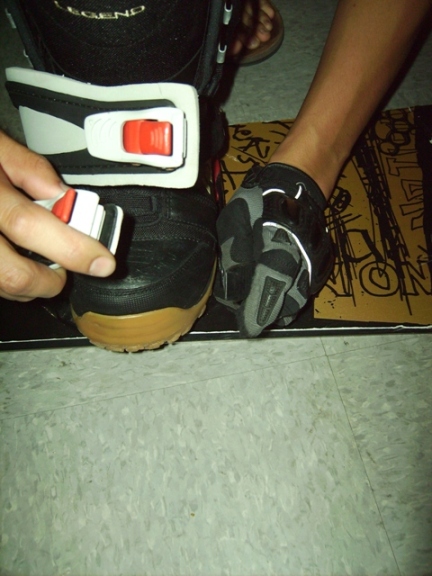
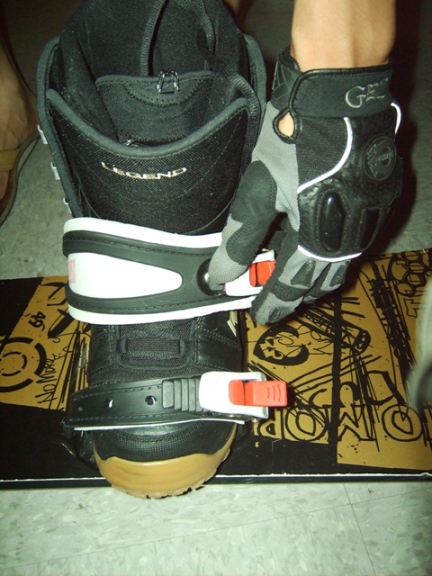
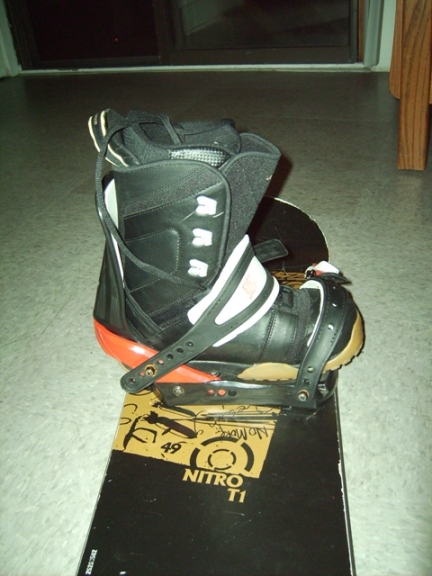
This procedure becomes more complicated when snow gloves are involved, as the ratchets and mounting disc are more difficult to adjust. During our user study, we asked a potential end use customer to change the angle of the mounting disc, as he would on the top of the mountain if he wanted to switch styles of riding. In order to do this, the customer was required to remove the boot, unscrew the mounting disc, and repeat the steps listed above. This process became much more time consuming when we asked the rider to repeat the process with a snowboard glove on.
Areas for Improvement:
After analyzing the ease of use, we found the following that could increase the usability of the binding:
Mounting Disc- Removing gloves and rotating the mounting disc would be very difficult to do in very cold temperatures, often encountered while snowboarding. In order to improve comfort for the rider, we suggest the mounting disc be adjustable without completely detaching the binding from the snowboard, and with the rider wearing gloves.
Pictures of Assembly
Below are some images of the snowboard and binding components. The individual components of the bindings are shown zoomed in, but for a better view of each individual component, please refer to the Bill of Materials.
The Snowboard
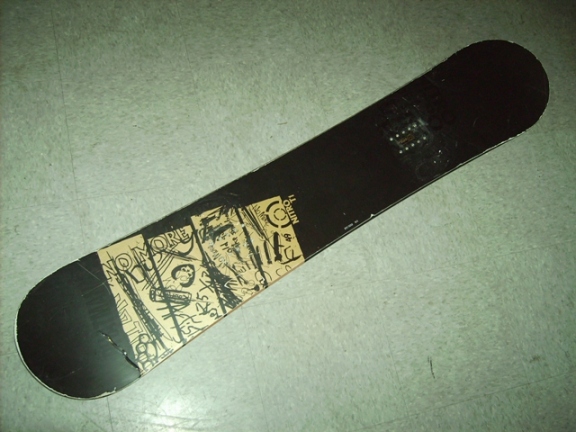
Where the bindings are mounted
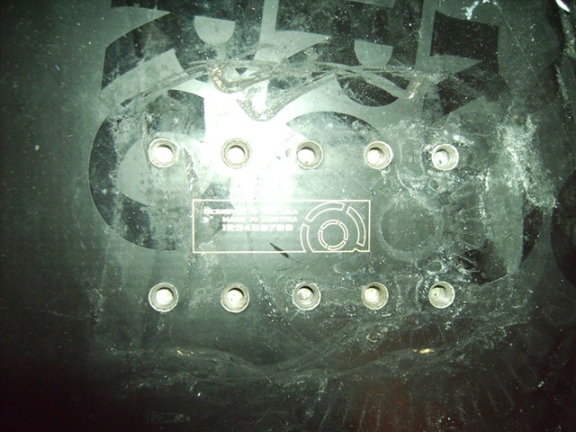
Overhead of Snowboard binding assembly
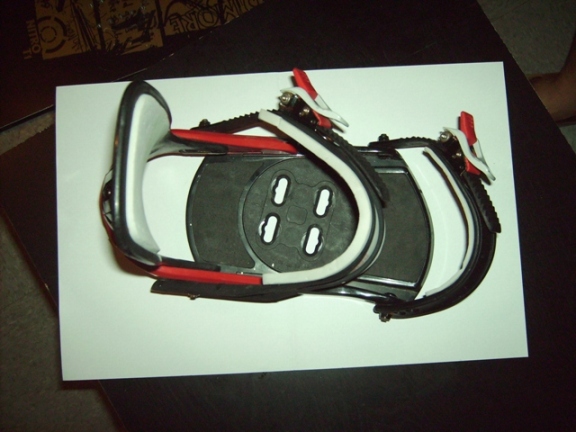
Ankle strap ratchet buckle

Toe strap ratchet buckle

Ankle strap; consists of ankle riser, long ladder, padded ankle strap, and ankle ratchet buckle
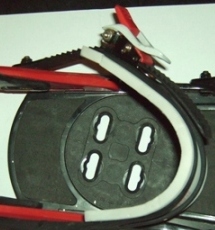
Toe strap; consists of toe riser, toe ladder, padded toe strap, and toe ratchet buckle
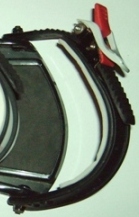
Hi Back
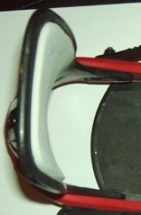
Bill of Materials
The following is a parts list of all the components that make up ONE snowboard binding (as in the left or right, but not both). It includes the weight of each component, the material which it is made of, and a picture of the piece. There's total of 63 parts to each binding. While many of these parts are nuts, bolts, and washers, it shows that there is more complexity to a binding than one might expect.

Function: how each component functions
1) Toe Ladder Strap – Attached to the baseplate, the toe ladder strap engages with the toe ratchet buckle to secure the padded toe strap over the toe of the snowboard boot. Provides leverage for increased heel edge power.
2) Toe Riser – Secures the other side of the padded toe strap to the baseplate. Allows for padded toe strap adjustment; the toe riser can shorten or lengthen the overall toe strap length.
3) Toe ratchet buckle – Engages with the toe ladder strap and is fixed to the padded toe strap. Allows the user to quickly adjust the overall length of the toe strap with a ratchet system. Ensures that the snowboard boot’s toe section is secured to the baseplate of the binding. Also features a quick ladder strap release lever.
4) Padded Toe Strap – Rests on top of the toe of the snowboard boot. Provides relief while exerting forces on the heel edge of the snowboard, toe strap, and baseplate. Attaches to the toe riser and toe ratchet buckle.
5) Long ladder Strap – Also attached to the baseplate, the long ladder strap engages with the ankle ratchet buckle to secure the padded ankle strap over the ankle portion of the snowboard boot. Provides leverage for increased toe edge power.
6) Ankle Riser - Secures the other side of the padded ankle strap to the baseplate. Allows for padded ankle strap adjustment; the ankle riser can shorten or lengthen the overall ankle strap length.
7) Ankle ratchet buckle - Engages with the long ladder strap and is fixed to the padded ankle strap. Allows the user to quickly adjust the overall length of the ankle strap with a ratchet system. Ensures that the snowboard boot’s ankle section is secured to the baseplate of the binding. Also features a quick ladder strap release lever.
8) Padded ankle strap - Rests on top of the ankle section of the snowboard boot. Provides cushion while exerting forces on the toe edge of the snowboard, ankle strap, and baseplate. Attaches to the ankle riser and ankle ratchet buckle.
9) Hi back – Cupped to fit around the back of the snowboard boot. Pressing on the hi back increases heel edge power. The angle and height of the hi back affects performance. A greater angle or a higher hi back results in greater heel edge power. A smaller forward lean or lower hi back results in more comfort and boot movement freedom.
10) Baseplate – The component between the snowboard boot and snowboard deck. Serves as padding for increased shock absorption capabilities. Because it increases the distance between the snowboard and snowboard boot, the baseplate also reduces toe drag.
11) Heelcup – Controls how far off the snowboard the heel of the snowboard boot hangs. Provides heel support and prevents rotation of the boots while strapped in. Attached to the baseplate and hi back.
12) Mounting Disc – This component mates the binding baseplate to the snowboard deck. Fits into the baseplate to determine binding mount angle. Typically has four slots in which four screws and washers fit and secure the binding to the snowboard. Also improves shock absorption abilities of the overall binding.
Failure Modes and Effects Analysis
Failure modes and effects analysis (FMEA) is an effective tool in identifying a product’s strengths and weaknesses. The process begins by listing all components/parts of a product. Each component is then analyzed to determine different possible failure modes and effects of each failure mode. The failures are rated according to the legend below. The failures and effects of failures are assessed on a scale from 1 to 10, 1 being lowest and 10 highest. Finally, a recommended action may be proposed if necessary and each component is reevaluated (*).
The table below lists the separate components of a snowboard binding and assesses different modes in which these components may fail.
Legend :
(S) – Severity of the Failure
(O) – rate of occurrence
(D) – Detectability of the problem
RPN – Risk Priority Number; = S*O*D

Design for Environment
Recent growing concerns over human environmental impact have stirred engineers to become more aware of their designs and the impact on the environment. This growing awareness brings about a new engineering aspect entitled “Design for Environment”. In our analysis of the snowboard binding, we considered various guidelines when determining the product’s environmental influence. Since the usage of the product does not require any external sources or energy input (besides that of the user).Therefore, we have found the analysis of the environmental impacts of snowboard binding usage negligible.
We used a template for analysis called Life Cycle Assessment (LCA) which examines each process associated with the manufacture, production, use, and disposal of the product. The following flow chart represents the various aspects of the life cycle of a snowboard binding.
We have used software that produces an Economic Input-Output LCA (EIO-LCA) in order to quickly analyze the chart above. This program uses industry sector averages to predict economic and environmental impact based on the supply chain needed to generate a given demand. The main material used in the life cycle for the product is plastic, and we have therefore chosen to use the model for “Other Plastic Product Manufacturing” sector for a design for environment analysis.
Manufacturing
Economic Activity
The results show that the main economic activity in producing a demand of one million dollars is credited towards other plastics product manufacturing. These results predict that for the demand given, we can assume a total economic activity increase of $2.36 million.

Greenhouse Gas Emissions
The results of the EIO-LCA show an increase of 862 metric tons of CO2 equivalent (MTCO2E) per $1 million increase in demand for snowboard bindings. This increase is mainly attributed to the power generation and supply needed to manufacture the plastic products. We have noted that the predicted emissions associated with other plastics product manufacturing accounts for only 4% of total greenhouse gas emissions.

Energy
Inducing a demand of $1 million produces a predicted energy increase of 14.7 terajoules (TJ) for all sectors. Again, we see the main source for this increased energy demand stems from power generation and supply, as well as from plastic material and resin manufacturing.
Both energy demand and greenhouse gas emission results from the EIO-LCA list truck transportation as a top ten contributor to environmental effect. The product features components that can be easily stacked and folded. Based on this design of the product, we feel that the packing design has been optimized and allows for maximum efficiency in transporting the product.
End Use/Disposal
The design of the product involves various components which can easily be disassembled, therefore providing optimum end-use efficiency. Separate components can be replaced upon failure instead of replacing the entire product assembly.
The toe and upper straps of the binding contain a comfort foam strip attached to the plastic which interferes with recycling. A recommendation here would be to re-design the straps so that the foam strip can be easily removed prior to disposal.
Conclusions
Based on the results found from our EIO-LCA analysis, the main environmental impacts are attributed to the power generation and supply needed to support an increased product demand of $1 million dollars. Given that the usage of the product results in nominal (or no) environmental impact, almost all impact is attributed to the production of the snowboard binding.
In order to decrease the environmental effects of producing the binding, one could look at incorporating more energy efficient manufacturing methods, as well as using biodegradable plastics. A more detailed analysis of using biodegradable material in injection molding (main manufacturing method used) should be conducted in order to recommend the use of a specific bioplastic.
The vast majority of the binding consists of plastic materials. There were a small number of metallic components that were not included in this analysis, as their impact was assumed to be negligible. Also, the use of online software to perform an EIO-LCA produces very general and basic results. To add to this inaccuracy, the software did not specify snowboard bindings as a source for Other Plastics Product Manufacturing. A further study would include a more accurate data source/software, as well as including the excluded components. We feel that these inaccuracies did not affect the basic design for environment analysis of the product, nor did it affect our ability to provide recommendations for improving the product.
Mechanical Analysis
Moments About Large Rivet
-F1d1 + F2d2 = 0
15 lb * 4.448 N/lb 66.72 N
66.72 N * 0.040 m = F2 * 0.009 m
F2 = 296.53 N = 66.66 lb
Reaction Force At Point A
Bx = 66.66 N
By = 0.0 N
Cx = (296.53 N) * sin(50o) = 227.16
Cy = -(296.53 N) * cos(50o) = -190.61
Sum Fx = 66.66 N + 227.16 = 293.83
Sum Fy = 0.0 N - 190.61 = -190.61
FA2 = 293.832 N + 190.612 N = (350.23 N)2
FA = 350.23 N
Peer Roles
Sean Hamilton:
Kaila Santiago:
Spiro Kiroubalis:
Michael Li:
